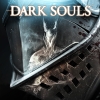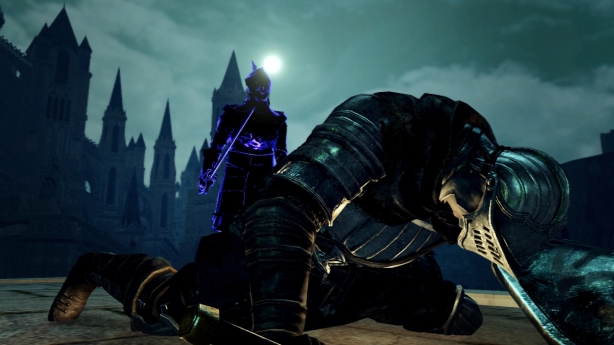Dark Souls Preview
 Of the five big new titles available at the Namco Summer Shindig, Dark Souls seemed to be Namco’s low-key favourite. It appears that Namco know they have an excellent game on their hands, but are also aware that even in 2011 it is quite a niche title. So they displayed it confidently yet cautiously; with presentations that extolled the game’s strengths whilst never resorting to the “it’s-for-everyone, it’s-a-game-changer” PR platitudes reserved for some of the other titles on offer.
Of the five big new titles available at the Namco Summer Shindig, Dark Souls seemed to be Namco’s low-key favourite. It appears that Namco know they have an excellent game on their hands, but are also aware that even in 2011 it is quite a niche title. So they displayed it confidently yet cautiously; with presentations that extolled the game’s strengths whilst never resorting to the “it’s-for-everyone, it’s-a-game-changer” PR platitudes reserved for some of the other titles on offer.
The Dark Souls demo gave players the opportunity to try one of half a dozen different player classes in a section of the game that, when talking about just about any other title on the planet, would be described as “bitchingly hard” or “like eating or concrete sandwich”. In Dark Souls it is merely described as “about par for the course” or, when condescending to whelps like me, “yeah, a little bit tricky…but not too bad”.
It also served to highlight what is so unique about the game made by From Software. The game has multiple routes, but the player is actively discouraged from exploring them because it is just too difficult to explore every area of the game. Pick your route, pick your poison. Some boss characters are deliberately designed to be almost impassable with some character classes. Namco told us that a particular gargoyle boss in the demo was immune to fire and fire type attacks, which made taking it on with a pyromancer character a quick ticket to deadsville.
So it is game design, but not as we know it. It appears that Dark Souls is a response to the videogame industry’s obsession with accessibility, its need to allow every player to see every section of the game world, as if funding for later levels would be withdrawn unless reaching them was within every player’s capability. We were shown areas of Dark Souls where the player could move through a level and then open shortcuts behind them, seemingly at first giving simpler access to crossroad rooms and safe areas, where players choose which new test they will undertake. However, it was quickly explained that these shortcuts are not for going back; they simply saved you from doing everything again when you die.
The key word in the previous sentence is when; when you die. You die a lot in Dark Souls, just like in Demon’s Souls. The game design philosophy remains that when you dip your toes into the next level, expect them to get bitten off. Like trying to drive an F1 car up a ski slope, you feel like you have the tools to get the job done but spend more time backwards and in circles than making forward progress. Players carry a vicious armoury, solid shield and agile dodge move, but their use is restricted by a stamina bar that is sapped to zero by a couple of sword slashes or a well timed roll, meaning that any conflict is a precarious dance between player and enemy who, unusually for a single player game, all feel like the have the capability to beat you. Attack and defence animations are long and drawn out and a missed sword stroke or parry leaves the player incredibly vulnerable. One on hand, this makes combat thoughtful, tactical and steady. On the other, it makes the game feel unresponsive and viciously punishing, with slight errors in button pressing leaving the player unable to protect themselves for reasonable lengths of time.
It is this mode of difficulty that will continue to make this series so divisive. Dark Souls isn’t hard in a way that other notably tough action games like Devil May Cry are, where your avatar is the most powerful being in the game world and responds immediately to any button press, the challenge coming from enemies that simply overwhelm your twitch fibres and ability to react to the action on screen. Dark Souls just makes it clear that your character is weak and fragile, susceptible to any enemy at any moment, just waiting for lapses in concentration. It also rewards the player differently. Rather than the sensation of player skill and feeling of excellence offered by other action games (deserved or not), Dark Souls rewards attritional thinking and the rote learned planning that comes from one hundred failures.
Dark Souls is released in October but it seems clear, even at this stage, what the game offers. Fans of the first game and players seeking a challenge will revel in its difficulty whereas players looking for an experience they can move through more serenely, enjoying the story whilst they stop and smell the roses shouldn’t even flirt with the idea of playing. This is to be commended, and from the brief time available with Dark Souls it is clear that, both from playing the game and listening to the way it is talked about, this is not a game for everyone, nor is it intended to be. In an industry that is obsessed with new IP hitting the biggest demographics and being attractive to as many people as possible, Dark Souls is a stubborn mule kick to convention, happy to have its hardcore following. In October, all the signs are that the hardcore will be happy to have it back.
[nggallery id=486]
Dark Souls is set for an October 7th release, for PlayStation 3 and Xbox 360.






